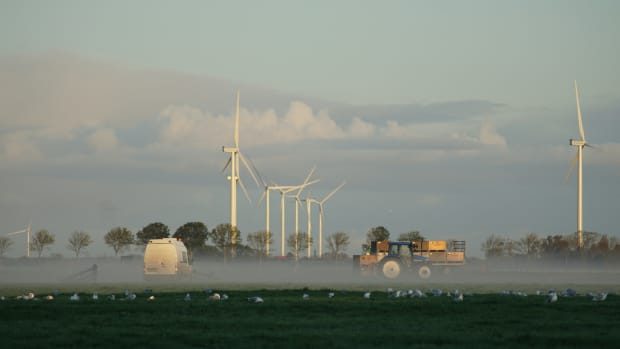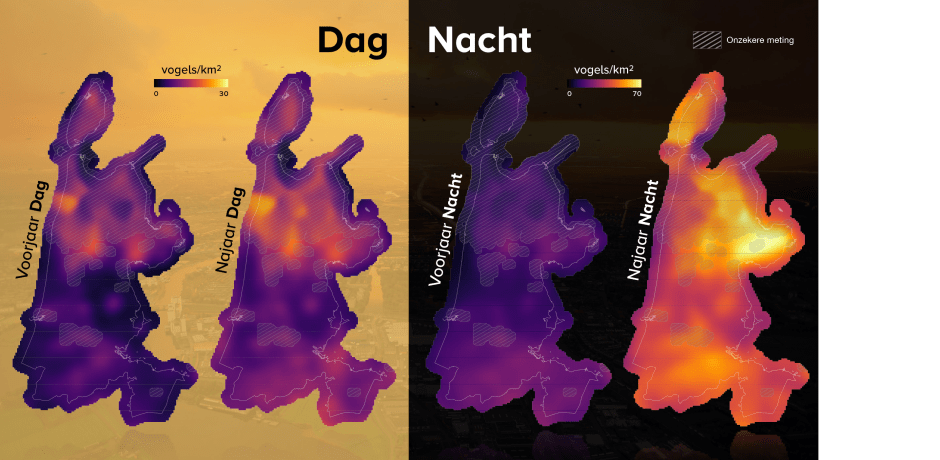
Wind turbines get in the way of migratory birds. Where do the most crashes happen?
Wind turbines in the Netherlands often lie on the route of bird migration. But where is the risk of collisions greatest now? UvA scientists from the Institute for Biodiversity and Ecosystem Dynamics (IBED) mapped this for North Holland.
Migratory birds do not always fly above windmills, UvA research shows. In fact, some 40 to 80 percent of the birds fly between 50 and 200 meters, right at the height of wind turbine rotor blades. For the first time, the researchers mapped for North Holland exactly where and at what altitude migratory birds fly. We posed six questions to UvA PhD student Bart Hoekstra.

How many migratory birds collide with wind turbines in the Netherlands every year?
“That is a very difficult question. Local research into this is being done in a number of places in the Netherlands, by counting carcasses of birds under wind turbines. But the estimates from this vary widely, the studies are very intensive and usually of short duration. To give you an idea: per turbine, you might find dead birds in a ten-hectare ‘trap area,’ but searching one hectare of that for months on end for sparrow-sized birds is already incredibly intense.”
“If I had to give an estimate, I would say the average would be somewhere between five and 20 birds per turbine per year.”
How problematic is that for bird species?
“You have to see it against the background of the enormous scale on which wind energy is now being developed, worldwide. Along the entire migration route of birds, on land and at sea, an enormous number of wind farms are going to be built. You can imagine that bird species that are already doing poorly will have problems as a result. Incidentally, climate change is also a big problem for birds, so it is important to make wind energy as bird-friendly as possible.”
How can you prevent collisions with migratory birds?
“In several ways. By positioning wind turbines differently in the landscape or by stopping them when there is a peak in bird migration. We thought that if we make a map that shows exactly where the bird migration takes place, then you can make an estimate based on that of where the risk of collisions is greatest. Even if you don't know exactly how many birds fly into wind turbines, that knowledge can help prevent collisions.”
(Text continues below the image.)

What stood out about the map you created?
“What struck me was the hotspot in West Friesland, the region of Hoorn, Andijk, Enkhuizen. That's where a huge nocturnal bird migration takes place in the fall. I didn't expect that, but in retrospect it makes sense. It's a place where North Holland sticks out into the IJsselmeer region. And birds are naturally inclined to make the shortest crossing over the water there.”
“I also noticed that north of Amsterdam is relatively quiet in terms of bird migration: both in spring and autumn and both during the day and at night. I live in Amsterdam-Noord and when I cycle around the hinterland you see that in terms of breeding birds, it is a very bird-rich area, while at the same time, not much bird migration takes place.”
With this information, will governments choose to stop wind turbines during bird migration, place wind turbines elsewhere or remove them?
“That is ultimately up to the government and wind farm owners. Our research is only a small piece of the puzzle in an incredibly complex issue. Exactly how wind turbines are placed has to do with noise pollution, cast shadow, infrastructure, approach routes from Schiphol Airport, you name it.”
“In the Netherlands, the potential locations for wind turbines are already fairly fixed, and I don’t expect them to change any time soon. But I do think it can help prioritize where you can and cannot shut down wind turbines during bird migration. After all, shutting down all wind farms at once is not always an option in terms of energy supply.”
“More may be possible in less densely populated countries. There, this kind of bird migration map can be used to choose locations for wind farms at an early stage.”
In May 2023, offshore wind farms were shut down for the first time to give migratory birds a safe crossing, thanks to the UvA’s bird migration prediction model. When can we expect the first onshore wind turbines to be shut down for bird migration?
“I hope sometime after 2026. We are working on a land-based bird migration prediction model based on this map and weather forecasts, but it still needs to be produced. Also, the decision-making process on land is much more complicated because there are many more parties involved.”

